Rocket

A rocket or rocket vehicle is a missile, spacecraft, aircraft or other vehicle which obtains thrust by the reaction of the rocket to the ejection of fast moving fluid exhaust from a rocket engine. Chemical rockets create their exhaust by the combustion of rocket propellant. The action of the exhaust against the inside of combustion chambers and expansion nozzles is able to accelerate the gas to hypersonic speed, and this exerts a large reactive thrust on the rocket (an equal and opposite reaction in accordance with Newton's third law).
Rockets, in the form of military and recreational uses, date back to at least the 13th century.[1] Widespread military, scientific, and industrial use did not occur until the 20th century, when rocketry was the enabling technology of the Space Age, including setting foot on the moon.
Rockets are used for fireworks, weaponry, ejection seats, launch vehicles for artificial satellites, human spaceflight and exploration of other planets. While comparatively inefficient for low speed use, they are very lightweight and powerful, capable of generating large accelerations and of attaining extremely high speeds with reasonable efficiency.
Chemical rockets store a large amount of energy in an easily-released form, and can be very dangerous. However, careful design, testing, construction and use minimizes risks.
History of rockets
In antiquity

The availability of black powder (gunpowder) to propel projectiles was a precursor to the development of the first solid rocket. Ninth Century Chinese Taoist alchemists discovered black powder while searching for the Elixir of life; this accidental discovery led to experiments in the form of weapons such as bombs, cannon, incendiary fire arrows and rocket-propelled fire arrows.[nb 1][nb 2] The discovery of gunpowder was probably the product of centuries of alchemical experimentation.[4]
Exactly when the first flights of rockets occurred is contested. Some say that the first recorded use of a rocket in battle was by the Chinese in 1232 against the Mongol hordes. There were reports of fire arrows and 'iron pots' that could be heard for 5 leagues (25 km, or 15 miles) when they exploded upon impact, causing devastation for a radius of 600 meters (2,000 feet), apparently due to shrapnel.[5] The lowering of the iron pots may have been a way for a besieged army to blow up invaders. The fire arrows were either arrows with explosives attached, or arrows propelled by gunpowder, such as the Korean Hwacha.[nb 3]
Less controversially, one of the earliest devices recorded that used internal-combustion rocket propulsion was the 'ground-rat,' a type of firework, recorded in 1264 as having frightened the Empress-Mother Kung Sheng at a feast held in her honor by her son the Emperor Lizong.[7]
Subsequently, one of the earliest texts to mention the use of rockets was the Huolongjing, written by the Chinese artillery officer Jiao Yu in the mid-14th century. This text also mentioned the use of the first known multistage rocket, the 'fire-dragon issuing from the water' (huo long chu shui), used mostly by the Chinese navy.[8]
Spread of rocket technology

Rocket technology first became known to Europeans following its use by the Mongols Genghis Khan and Ögedei Khan when they conquered parts of Russia, Eastern, and Central Europe. The Mongolians had acquired the Chinese technology by conquest of the northern part of China and also by the subsequent employment of Chinese rocketry experts as mercenaries for the Mongol military. Reports of the Battle of Mohi in the year 1241 describe the use of rocket-like weapons by the Mongols against the Magyars.[5] Rocket technology also spread to Korea, with the 15th century wheeled hwacha that would launch singijeon rockets.
Additionally, the spread of rockets into Europe was also influenced by the Ottomans at the siege of Constantinople in 1453, although it is very likely that the Ottomans themselves were influenced by the Mongol invasions of the previous few centuries. In their history of rockets published on the Internet, NASA says "Rockets appear in Arab literature in 1258 A.D., describing Mongol invaders' use of them on February 15 to capture the city of Baghdad."[5]
Between 1270 and 1280, Hasan al-Rammah wrote al-furusiyyah wa al-manasib al-harbiyya (The Book of Military Horsemanship and Ingenious War Devices), which included 107 gunpowder recipes, 22 of which are for rockets.[9] According to Ahmad Y Hassan, al-Rammah's recipes were more explosive than rockets used in China at the time.[10]
The name Rocket comes from the Italian Rocchetta (i.e. little fuse), a name of a small firecracker created by the Italian artificer Muratori in 1379.[11]
Between 1529 and 1556 Conrad Haas wrote a book in which he described rocket technology, involving the combination of fireworks and weapons technologies. This manuscript was discovered in 1961, in the Sibiu public records (Sibiu public records Varia II 374). His work dealt with the theory of motion of multi-stage rockets, different fuel mixtures using liquid fuel, and introduced delta-shape fins and bell-shaped nozzles.[12]
For over two centuries, the work of Polish-Lithuanian Commonwealth nobleman Kazimierz Siemienowicz "Artis Magnae Artilleriae pars prima" ("Great Art of Artillery, the First Part", also known as "The Complete Art of Artillery"), was used in Europe as a basic artillery manual.[13] First printed in Amsterdam in 1650 it was translated to French in 1651, German in 1676, English and Dutch in 1729 and Polish in 1963. The book provided the standard designs for creating rockets, fireballs, and other pyrotechnic devices. It contained a large chapter on caliber, construction, production and properties of rockets (for both military and civil purposes), including multi-stage rockets, batteries of rockets, and rockets with delta wing stabilizers (instead of the common guiding rods).
In 1792, iron-cased rockets were successfully used militarily by Tipu Sultan, Ruler of the Kingdom of Mysore in India against the larger British East India Company forces during the Anglo-Mysore Wars. The British then took an active interest in the technology and developed it further during the 19th century.
Accuracy of early rockets
[[Rockets] at the US National Parks Service, Fort McHenry National Monument and Historic Shrine. Retrieved February 2008.</ref> Rockets were also used in the Battle of Waterloo.[14]
Early rockets were very inaccurate. Without the use of spinning or any gimballing of the thrust, they had a strong tendency to veer sharply off course. The early British Congreve rockets[15] reduced this somewhat by attaching a long stick to the end of a rocket (similar to modern bottle rockets) to make it harder for the rocket to change course. The largest of the Congreve rockets was the 32-pound (14.5 kg) Carcass, which had a 15-foot (4.6 m) stick. Originally, sticks were mounted on the side, but this was later changed to mounting in the center of the rocket, reducing drag and enabling the rocket to be more accurately fired from a segment of pipe.
The accuracy problem was greatly improved in 1844 when William Hale[16] modified the rocket design so that thrust was slightly vectored, causing the rocket to spin along its axis of travel like a bullet. The Hale rocket removed the need for a rocket stick, travelled further due to reduced air resistance, and was far more accurate.
Theories of interplanetary rocketry
In 1903, high school mathematics teacher Konstantin Tsiolkovsky (1857–1935) published Исследование мировых пространств реактивными приборами[17] (The Exploration of Cosmic Space by Means of Reaction Devices), the first serious scientific work on space travel. The Tsiolkovsky rocket equation—the principle that governs rocket propulsion—is named in his honor (although it had been discovered previously).[18] He also advocated the use of liquid hydrogen and oxygen for propellant, calculating their maximum exhaust velocity. His work was essentially unknown outside the Soviet Union, but inside the country it inspired further research, experimentation and the formation of the Society for Studies of Interplanetary Travel in 1924.
In 1912, Robert Esnault-Pelterie published a lecture[19] on rocket theory and interplanetary travel. He independently derived Tsiolkovsky's rocket equation, did basic calculations about the energy required to make round trips to the Moon and planets, and he proposed the use of atomic power (i.e. Radium) to power a jet drive.
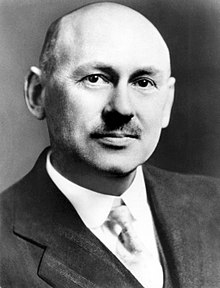
In 1912 Robert Goddard began a serious analysis of rockets, concluding that conventional solid-fuel rockets needed to be improved in three ways. First, fuel should be burned in a small combustion chamber, instead of building the entire propellant container to withstand the high pressures. Second, rockets could be arranged in stages. And third, the exhaust speed (and thus the efficiency) could be greatly increased to beyond the speed of sound by using a De Laval nozzle. He patented these concepts in 1914.[20] He, also, independently developed the mathematics of rocket flight.
In 1920, Goddard published these ideas and experimental results in A Method of Reaching Extreme Altitudes.[21] The work included remarks about sending a solid-fuel rocket to the Moon, which attracted worldwide attention and was both praised and ridiculed. A New York Times editorial suggested:
That Professor Goddard, with his 'chair' in Clark College and the countenancing of the Smithsonian Institution, does not know the relation of action to reaction, and of the need to have something better than a vacuum against which to react -- to say that would be absurd. Of course he only seems to lack the knowledge ladled out daily in high schools.
— New York Times, 13 January 1920[22]
In 1923, Hermann Oberth (1894–1989) published Die Rakete zu den Planetenräumen ("The Rocket into Planetary Space"), a version of his doctoral thesis, after the University of Munich rejected it.[23]
In 1924, Tsiolkovsky also wrote about multi-stage rockets, in 'Cosmic Rocket Trains'[24]
Modern rocketry
Pre-World War II
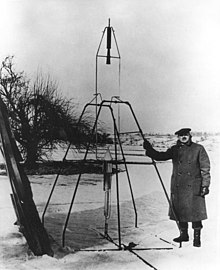
Modern rockets were born when Goddard attached a supersonic (de Laval) nozzle to a liquid-fueled rocket engine's combustion chamber. These nozzles turn the hot gas from the combustion chamber into a cooler, hypersonic, highly directed jet of gas, more than doubling the thrust and raising the engine efficiency from 2% to 64%.[25][26] In 1926, Robert Goddard launched the world's first liquid-fueled rocket in Auburn, Massachusetts.
During the 1920s, a number of rocket research organizations appeared worldwide. In the mid-1920s, German scientists had begun experimenting with rockets which used liquid propellants capable of reaching relatively high altitudes and distances. 1927 the German car manufacturer Opel began to research rocket vehicles together with Mark Valier and the rocket builder Friedrich Wilhelm Sander.[27] In 1928, Fritz von Opel drove with a rocket car, the Opel-RAK.1 on the Opel raceway in Rüsselsheim, Germany. In 1929 von Opel started at the Frankfurt-Rebstock airport with the Opel-Sander RAK 1-airplane. This was maybe the first flight with a manned rocket-aircraft. In 1927 and also in Germany, a team of amateur rocket engineers had formed the Verein für Raumschiffahrt (German Rocket Society, or VfR), and in 1931 launched a liquid propellant rocket (using oxygen and gasoline).[28]
From 1931 to 1937, the most extensive scientific work on rocket engine design occurred in Leningrad, at the Gas Dynamics Laboratory. Well-funded and staffed, over 100 experimental engines were built under the direction of Valentin Glushko. The work included regenerative cooling, hypergolic propellant ignition, and fuel injector designs that included swirling and bi-propellant mixing injectors. However, the work was curtailed by Glushko's arrest during Stalinist purges in 1938. Similar work was also done by the Austrian professor Eugen Sänger who worked on rocket powered spaceplanes such as Silbervogel (sometimes called the 'antipodal' bomber.)[29]
On November 12 1932 at a farm in Stockton NJ, the American Interplanetary Society's attempt to static fire their first rocket (based on German Rocket Society designs) fails in a fire.[30]
In 1932, the Reichswehr (which in 1935 became the Wehrmacht) began to take an interest in rocketry. Artillery restrictions imposed by the Treaty of Versailles limited Germany's access to long distance weaponry. Seeing the possibility of using rockets as long-range artillery fire, the Wehrmacht initially funded the VfR team, but seeing that their focus was strictly scientific, created its own research team. At the behest of military leaders, Wernher von Braun, at the time a young aspiring rocket scientist, joined the military (followed by two former VfR members) and developed long-range weapons for use in World War II by Nazi Germany.[31]
World War II

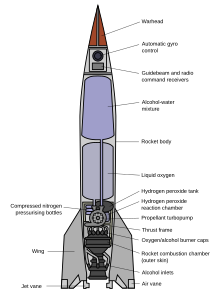
In 1943, production of the V-2 rocket began in Germany. It had an operational range of 300 km (190 mi) and carried a 1,000 kg (2,200 lb) warhead, with an amatol explosive charge. It normally achieved an operational maximum altitude of around 90 km (56 mi), but could achieve 206 km (128 mi) if launched vertically. The vehicle was similar to most modern rockets, with turbopumps, inertial guidance and many other features. Thousands were fired at various Allied nations, mainly England, as well as Belgium and France. While they could not be intercepted, their guidance system design and single conventional warhead meant that it was insufficiently accurate against military targets. 2,754 people in England were killed, and 6,523 were wounded before the launch campaign was terminated. There were also 20,000 deaths of slave labour during the construction of V-2s. While it did not significantly affect the course of the war, the V-2 provided a lethal demonstration of the potential for guided rockets as weapons.[32][33]
In parallel with the guided missile programme in Nazi Germany, rockets were also used on aircraft, either for assisting horizontal take-off (JATO), vertical take-off (Bachem Ba 349 "Natter") or for powering them (Me 163,[34] etc.)
During the Great Patriotic War the Soviet Union developed and heavily used the Katyusha rocket. It proved to be highly successful against the Nazi military machine.
Post World War II

At the end of World War II, competing Russian, British, and US military and scientific crews raced to capture technology and trained personnel from the German rocket program at Peenemünde. Russia and Britain had some success, but the United States benefited the most. The US captured a large number of German rocket scientists (many of whom were members of the Nazi Party, including von Braun) and brought them to the United States as part of Operation Overcast.[35] In America, the same rockets that were designed to rain down on Britain were used instead by scientists as research vehicles for developing the new technology further. The V-2 evolved into the American Redstone rocket, used in the early space program.[36]
After the war, rockets were used to study high-altitude conditions, by radio telemetry of temperature and pressure of the atmosphere, detection of cosmic rays, and further research; notably for the Bell X-1 to break the sound barrier. This continued in the US under von Braun and the others, who were destined to become part of the US scientific complex.
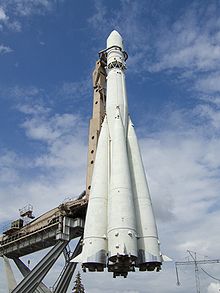
Independently, research continued in the Soviet Union under the leadership of the chief designer Sergei Korolev.[37] With the help of German technicians, the V-2 was duplicated and improved as the R-1, R-2 and R-5 missiles. German designs were abandoned in the late 1940s, and the foreign workers were sent home. A new series of engines built by Glushko and based on inventions of Aleksei Mihailovich Isaev formed the basis of the first ICBM, the R-7.[38] The R-7 launched the first satellite- Sputnik 1, and later Yuri Gagarin-the first man into space, and the first lunar and planetary probes. This rocket is still in use today. These prestigious events attracted the attention of top politicians, along with additional funds for further research.
One problem that had not been solved was atmospheric reentry- it had been shown that an orbital vehicle easily had enough kinetic energy to vaporize itself, and yet it was known that meteorites can make it down to the ground. The mystery was solved in the US in 1951 when H. Julian Allen and A. J. Eggers, Jr. of the National Advisory Committee for Aeronautics (NACA) made the counterintuitive discovery[39] that a blunt shape (high drag) permitted the most effective heat shield. With this type of shape, around 99% of the energy goes into the air rather than vehicle, and this permitted safe recovery of orbital vehicles.

The Allen and Eggers discovery, though initially treated as a military secret, was eventually published in 1958.[40] The Blunt Body Theory made possible the heat shield designs that were embodied in the Mercury and all other space capsules and space planes, enabling astronauts to survive the fiery re-entry into Earth's atmosphere.
Cold war
Rockets became extremely important militarily in the form of modern intercontinental ballistic missiles (ICBMs) when it was realized that nuclear weapons carried on a rocket vehicle were essentially not defensible against once launched, and ICBM/Launch vehicles such as the R-7, Atlas and Titan became the delivery platform of choice for these weapons.
Fueled partly by the Cold War, the 1960s became the decade of rapid development of rocket technology particularly in the Soviet Union (Vostok, Soyuz, Proton) and in the United States (e.g. the X-15[41] and X-20 Dyna-Soar[42] aircraft). There was also significant research in other countries, such as Britain, Japan, Australia, etc. and their growing use for Space exploration, with pictures returned from the far side of the Moon and unmanned flights for Mars exploration.
In America the manned programmes, Project Mercury, Project Gemini and later the Apollo programme culminated in 1969 with the first manned landing on the moon via the Saturn V, causing the New York Times to retract their earlier editorial implying that spaceflight couldn't work:
Further investigation and experimentation have confirmed the findings of Isaac Newton in the 17th century and it is now definitely established that a rocket can function in a vacuum as well as in an atmosphere. The Times regrets the error.
— New York Times, 17 June 1969 - A Correction[43]
In the 1970s America made further lunar landings, before cancelling the Apollo programme. The replacement vehicle, the partially reusable 'Space Shuttle' was intended to be cheaper,[44] but this large reduction in costs was largely not achieved. Meanwhile in 1973, the expendable Ariane programme was begun, a launcher that by the year 2000 would capture much of the geosat market.
Current day
Rockets remain a popular military weapon. The use of large battlefield rockets of the V-2 type has given way to guided missiles. However rockets are often used by helicopters and light aircraft for ground attack, being more powerful than machine guns, but without the recoil of a heavy cannon and by the early 1960s air-to-air missiles became favoured. Current artillery systems as MLRS or Smerch launch multiple rockets to saturate battlefield targets with munitions.[citation needed]

Economically, rocketry is the enabler of all space technologies particularly satellites, many of which impact people's everyday lives in almost countless ways.[45]
Scientifically, rocketry has opened a window on the universe, allowing the launch of space probes to explore the solar system and space-based telescopes to obtain a clearer view of the rest of the universe.[46]
However, it is probably manned spaceflight that has predominantly caught the imagination of the public. Vehicles such as the Space Shuttle for scientific research, the Soyuz increasingly for orbital tourism and SpaceShipOne for suborbital tourism may show a trend towards greater commercialisation of manned rocketry.[47]
Types
Vehicle configurations

Many rockets are the archetypal tall thin "rocket" shape- that take off vertically, but there are many different types of rockets:[48][49]
- tiny models such as water rockets, skyrockets or small solid rockets that can be purchased at a hobby store
- missiles
- space rockets such as the enormous Saturn V used for the Apollo program
- rocket cars
- rocket powered aircraft
- rocket sleds
- rocket trains
- rocket torpedos[50][51]
- rocket powered jet packs[52]
- rapid escape systems such ejection seats and launch escape systems
- Space probes
Components of a rocket
Hardware
Rockets at minimum have propellant, a place to put propellant (such as a propellant tank), one or more rocket engines and nozzle, directional stabilization device(s) (such as fins, attitude jets or engine gimbals for thrust vectoring, gyroscopes) and a structure (typically monocoque) to hold these components together. Rockets intended for high speed atmospheric use also have an aerodynamic fairing such as a nose cone, which usually holds the payload.[53]
As well as these components, rockets can have any number of other components, such as wings (rocketplanes), wheels (rocket cars), even, in a sense, a person (rocket belt). Vehicles frequently possess navigation systems and guidance systems which typically use satellite navigation and inertial navigation systems.
Rocket engines
Rocket engines employ the principle of jet propulsion.[54] The rocket engines powering rockets come in a great variety of different types, a comprehensive list can be found in rocket engine. Most current rockets are chemically powered rockets (usually internal combustion engines,[55] but some employ a decomposing monopropellant) that emit a hot exhaust gas. A rocket engine can use gas propellants, solid propellant, liquid propellant, or a hybrid mixture of both solid and liquid.[54] Some rockets use heat or pressure that is supplied from a source other than the chemical reaction of propellant(s), such as steam rockets, solar thermal rockets, nuclear thermal rocket engines or simple pressurized rockets such as water rocket or cold gas thrusters.[54] With combustive propellants a chemical reaction is initiated between the fuel and the oxidizer in the combustion chamber, and the resultant hot gases accelerate out of a rocket engine nozzle (or nozzles) at the rearward-facing end of the rocket. The acceleration of these gases through the engine exerts force ("thrust") on the combustion chamber and nozzle, propelling the vehicle (in accordance with Newton's Third Law).[54]
Rocket propellant
Rocket propellant is mass that is stored, usually in some form of propellant tank or casing, prior to being used as the propulsive mass that is ejected from a rocket engine in the form of a fluid jet to produce thrust.[54] For chemical rockets often the propellants are a fuel such as liquid hydrogen or kerosene which is burned with an oxidizer such as liquid oxygen or nitric acid to produce large volumes of very hot gas. The oxidiser is either kept separate and mixed in the combustion chamber, or comes premixed, as with solid rockets.
Sometimes the propellant is not burned but still undergoes a chemical reaction, and can be a 'monopropellant' such as hydrazine, nitrous oxide or hydrogen peroxide that can be catalytically decomposed to hot gas.
Alternatively, an inert propellant can be used that can be externally heated, such as in steam rocket, solar thermal rocket or nuclear thermal rockets.[54]
For smaller, low performance, rockets such as attitude control thrusters where high performance is less necessary, a pressurised fluid is used as propellant that simply escapes the spacecraft through a propelling nozzle.[54]
Uses
Rockets or other similar reaction devices carrying their own propellant must be used when there is no other substance (land, water, or air) or force (gravity, magnetism, light) that a vehicle may usefully employ for propulsion, such as in space. In these circumstances, it is necessary to carry all the propellant to be used.
However, they are also useful in other situations:
Military

Some military weapons use rockets to propel a payloads to their targets. A rocket and its payload together are generally referred to as a missile, especially when the weapon has a guidance system (not all missiles use rocket engines, some use air breathing jets, turbojets, pulse jets or ramjets.) Anti tank and anti aircraft missiles use rocket engines to engage targets at high speed at a range of several miles, while intercontinental ballistic missiles can be used to deliver multiple nuclear warheads thousands of miles.
Science & Research
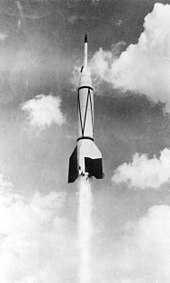
Sounding rockets are commonly used to carry instruments that take readings from Template:Km to mi to Template:Km to mi above the surface of the Earth, the altitudes between those reachable by weather balloons and satellites.[56]
Rocket engines are also used to propel rocket sleds along a rail at extremely high speed. The world record for this is Mach 8.5.[57]
Spaceflight
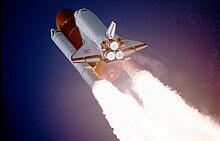
Larger rockets are normally launched from a launch pad which serves as stable support until a few seconds after ignition. Due to their high exhaust velocity - 2,500 to 4,500 m/s (9,000 to 16,200 km/h; 5,600 to 10,100 mph) (Mach ~10+), rockets are particularly useful when very high speeds are required, such as orbital speed (Mach 24+[58].) Spacecraft delivered into orbital trajectories become artificial satellites which are used for many commercial purposes. Indeed, rockets remain the only way to launch spacecraft into orbit and beyond.[59] They are also used to rapidly accelerate spacecraft when they change orbits or de-orbit for landing. Also, a rocket may be used to soften a hard parachute landing immediately before touchdown (see Soyuz spacecraft).
Rescue
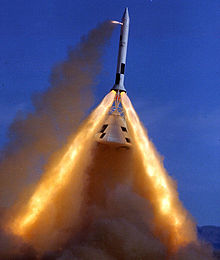
Rockets are used to propel a line to a stricken ship so that a Breeches buoy can be used to rescue those on board. Rockets are also used to launch emergency flares.
Some crewed rockets, notably the Saturn V[60] and Soyuz[61] have launch escape systems. This is a small, usually solid rocket that is capable of pulling the crewed capsule away from the main vehicle towards safety at a moments notice. These types of systems have been operated several times, both in testing and in flight, and operated correctly each time.[citation needed]
Solid rocket propelled ejection seats are used in many military aircraft to propel crew away to safety from a vehicle when flight control is lost.[62]
Hobby, sport and entertainment
Hobbyists build and fly model rockets of various types and rockets are used to launch both commercially available fireworks and professional fireworks displays.
Hydrogen peroxide rockets are used to power jet packs,[63] and have been used to power cars and a rocket car holds the all time (albeit unofficial) drag racing record.[64]
Noise
For all but the very smallest sizes, rocket exhaust compared to other engines is generally very noisy. As the hypersonic exhaust mixes with the ambient air, shock waves are formed. The sound intensity from these shock waves depends on the size of the rocket as well as the exhaust speed. The sound intensity of large, high performance rockets could potentially kill at close range.[65]
The Space Shuttle generates over 200 dB(A) of noise around its base. A Saturn V launch was detectable on seismometers a considerable distance from the launch site.
Generally speaking, noise is most intense when a rocket is close to the ground, since the noise from the engines radiates up away from the plume, as well as reflecting off the ground. This noise can be reduced somewhat by flame trenches with roofs, by water injection around the plume and by deflecting the plume at an angle.[66]
For crewed rockets various methods are used to reduce the sound intensity for the passengers as much as possible, and typically the placement of the astronauts far away from the rocket engines helps significantly. For the passengers and crew, when a vehicle goes supersonic the sound cuts off as the sound waves are no longer able to keep up with the vehicle.[67]
Physics
Operation

In all rockets, the exhaust is formed from propellants carried within the rocket prior to use.[54] Rocket thrust is due to the rocket engine, which propels the rocket forwards by exhausting the propellant rearwards at extreme high speed.

In a closed chamber, the pressures are equal in each direction and no acceleration occurs. If an opening is provided in the bottom of the chamber then the pressure is no longer acting on the missing section. The remaining pressures give a resultant thrust on the side opposite the opening, as well as permitting exhaust to escape. Using a nozzle increases the forces further since the pressure of expanding exhaust also acts on it, multiplying the thrust as a function of the area ratio of the nozzle. As a side effect the pressures act on the exhaust in the opposite direction and accelerate this to very high speeds (in accordance with Newton's Third Law).[54]
If propellant gas is continuously added to the chamber then this disequilibrium of pressures can be maintained for as long as propellant remains.[54]
Due to conservation of momentum the speed of the exhaust of a rocket determines how much momentum increase is created for a given amount of propellant. This is called the rocket's specific impulse.[54] Because a rocket, propellant and exhaust in flight, without any external perturbations, may be considered as a closed system, the total momentum is constant at all times. Therefore, the faster the net speed of the exhaust in one direction, the greater the speed of the rocket can achieve in the opposite direction, especially since the rocket mass is typically far lower than the final total exhaust mass.
As the remaining propellant decreases, rocket vehicles become lighter and their acceleration per unit of propellant tends to increase until the propellant is exhausted. This means that much of the speed change occurs towards the end of the burn when the vehicle is much lighter.[54]
Forces on a rocket in flight

The general study of the forces on a rocket or other spacecraft is called astrodynamics.
Flying rockets are primarily affected by the following:[68]
- Thrust from the engine(s)
- Gravity from celestial bodies
- Drag if moving in atmosphere
- Lift; usually relatively small effect except for rocket-powered aircraft
In addition, the inertia/centrifugal pseudo-force can be significant due to the path of the rocket around the center of a celestial body; when high enough speeds in the right direction and altitude are achieved a stable orbit or escape velocity is obtained.
During a rocket launch, as the vehicle speed increases, and the atmosphere thins, there is a point of maximum aerodynamic drag called Max Q. This determines the minimum aerodynamic strength of the vehicle, as the rocket must avoid buckling under these forces.[69]
These forces, with a stabilizing tail present will, unless deliberate control efforts are made, naturally cause the vehicle to follow a roughly parabolic trajectory termed a gravity turn, and this trajectory is often used at least during the initial part of a launch. (This is true even if the rocket engine is mounted at the nose). Vehicles can thus maintain low or even zero angle of attack which minimizes transverse stress on the launch vehicle; permitting a weaker, and hence lighter, launch vehicle.[70][71]
Net thrust

Underexpanded (above ambient).
Ambient.
Overexpanded (below ambient).
Grossly overexpanded.
If under or overexpanded then loss of efficiency occurs, grossly overexpanded nozzles lose less efficiency, but the exhaust jet is usually unstable. Rockets become progressively more underexpanded as they gain altitude. Note that almost all rocket engines will be momentarily grossly overexpanded during startup in an atmosphere.[72]
A typical rocket engine can handle a significant fraction of its own mass in propellant each second, with the propellant leaving the nozzle at several kilometres per second. This means that the thrust-to-weight ratio of a rocket engine, and often the entire vehicle can be very high, in extreme cases over 100. This compares with other jet propulsion engines that can exceed 5 for some of the better[73] engines.[74]
The propellant flow rate of a rocket is often deliberately varied over a flight, to provide a way to control the thrust and thus the airspeed of the vehicle. This, for example, allows minimization of aerodynamic losses[69] and can limit the increase of g-forces due to the reduction in propellant load.
It can be shown that the net thrust of a rocket is:
where:
- propellant flow (kg/s or lb/s)
- the effective exhaust velocity (m/s or ft/s)
The of a rocket engine is often almost constant in a vacuum, but in practice the effective exhaust velocity of rocket engines goes down when operated within an atmosphere as the atmospheric pressure goes up. In space, the effective exhaust velocity is equal to the actual exhaust velocity. In the atmosphere, the two velocities are close in value.
Impulse
The total impulse of a rocket burning its propellant is simply:[76]
When there is fixed thrust, this is simply:
Specific impulse
As can be seen from the thrust equation the effective speed of the exhaust controls the amount of thrust produced from a particular quantity of fuel burnt per second.
An equivalent measure, the net thrust-seconds (impulse) per weight unit of propellant expelled is called specific Impulse "" and this is one of the most important figures that describes a rocket's performance. It is defined such that it is related to the effective exhaust velocity by:
where:
- has units of seconds
- is the acceleration at the surface of the Earth
Thus, the greater the specific impulse, the greater the net thrust and performance of the engine. is determined by measurement while testing the engine. In practice the effective exhaust velocities of rockets varies but can be extremely high, ~4500 m/s, about 15 times the sea level speed of sound in air.
Delta-v (rocket equation)

The delta-v capacity of a rocket is the theoretical total change in velocity that a rocket can achieve without any external interference (without air drag or gravity or other forces).
When is constant, the delta-v that a rocket vehicle can provide can be calculated from the Tsiolkovsky rocket equation:[80]
where:
- is the initial total mass, including propellant, in kg (or lb)
- is the final total mass in kg (or lb)
- is the effective exhaust velocity in m/s or (ft/s)
- is the delta-v in m/s (or ft/s)
When launched from the Earth practical delta-v's for a single rockets carrying payloads can be a few km/s. Some theoretical designs have rockets with delta-v's over 9 km/s.
The required delta-v can also be calculated for a particular manoeuvre; for example the delta-v to launch from the surface of the Earth to Low earth orbit is about 9.7 km/s, which leaves the vehicle with a sideways speed of about 7.8 km/s at an altitude of around 200 km. In this manoeuvre about 1.9 km/s is lost in air drag, gravity drag and gaining altitude.
The ratio is sometimes called the mass ratio.
Mass ratios
Persons not familiar with spaceflight rarely realize that almost all of a launch vehicle's mass consists of propellant.[81] Mass ratio is, for any 'burn', the ratio between the rocket's initial mass and the mass after.[82] Everything else being equal, a high mass ratio is desirable for good performance, since it indicates that the rocket is lightweight and hence performs better, for essentially the same reasons that low weight is desirable in sports cars.
Rockets as a group have the highest thrust-to-weight ratio of any type of engine; and this helps vehicles achieve high mass ratios, which improves the performance of flights. The higher the ratio, the less engine mass is needed to be carried. This permits the carrying of even more propellant, enormously improving the delta-v. Alternatively, some rockets such as for rescue scenarios or racing carry relatively little propellant and payload and thus need only a lightweight structure and instead achieve high accelerations. For example, the Soyuz escape system can produce 20g.[61]
Achievable mass ratios are highly dependent on many factors such as propellant type, the design of engine the vehicle uses, structural safety margins and construction techniques.
The highest mass ratios are generally achieved with liquid rockets, and these types are usually used for orbital launch vehicles, a situation which calls for a high delta-v. Liquid propellants generally have densities similar to water (with the notable exceptions of liquid hydrogen and liquid methane), and these types are able to use lightweight, low pressure tanks and typically run high-performance turbopumps to force the propellant into the combustion chamber.
Some notable mass fractions are found in the following table (some aircraft are included for comparison purposes):
Staging
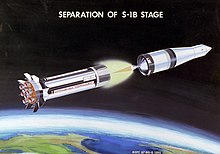

Often, the required velocity (delta-v) for a mission is unattainable by any single rocket because the propellant, tankage, structure, guidance, valves and engines and so on, take a particular minimum percentage of take-off mass that is too great for the propellant it carries to achieve that delta-v.
For example the first stage of the Saturn V, carrying the weight of the upper stages, was able to achieve a mass ratio of about 10, and achieved a specific impulse of 263 seconds. This gives a delta-v of around 5.9 km/s whereas around 9.4 km/s delta-v is needed to achieve orbit with all losses allowed for.
This problem is frequently solved by staging — the rocket sheds excess weight (usually empty tankage and associated engines) during launch. Staging is either serial where the rockets light after the previous stage has fallen away, or parallel, where rockets are burning together and then detach when they burn out.[83]
The maximum speeds that can be achieved with staging is theoretically limited only by the speed of light. However the payload that can be carried goes down geometrically with each extra stage needed, while the additional delta-v for each stage is simply additive.
Acceleration and thrust-to-weight ratio
From Newton's second law the acceleration of a vehicle is simply:
Where m is the instantaneous mass of the vehicle and is the net force acting on the rocket (mostly thrust but air drag and other forces can play a part.)
Typically, the acceleration of a rocket increases with time (if the thrust stays the same) as the weight of the rocket decreases as propellant is burned, but the thrust can be throttled to offset or vary this if needed. Discontinuities in acceleration will also occur when stages burn out, often starting at a lower acceleration with each new stage firing.
Peak accelerations can be increased by designing the vehicle with a reduced mass, usually achieved by a reduction in the fuel load and tankage and associated structures, but obviously this reduces range, final speed and burn time. Still, for some applications that rockets are used for, a high peak acceleration applied for just a short time is highly desirable.
The minimal mass of vehicle consists of a rocket engine with minimal fuel and structure to carry it. In that case the thrust-to-weight ratio[nb 4] of the rocket engine limits the maximum acceleration that can be designed. It turns out that rocket engines generally have truly excellent thrust to weight ratios (137 for the NK-33 engine,[85] some solid rockets are over 1000[84]), and nearly all really high-g vehicles employ or have employed rockets.
The high accelerations that rockets naturally possess means that rocket vehicles are often capable of vertical takeoff; this can be done provided the vehicles engines provide more than the local gravitational acceleration away from the Earth or gravity source.
Energy efficiency

Rocket launch vehicles take-off with a great deal of flames, noise and drama, and it might seem obvious that they are grievously inefficient. However, while they are far from perfect, their energy efficiency is not as bad as might be supposed.
The energy density of a typical rocket propellant is often around 1/3 that of conventional hydrocarbon fuels; the bulk of the mass is in the form of (often relatively inexpensive) oxidizer. Nevertheless, at take-off the rocket has a great deal of energy in the form of fuel and oxidizer stored within the vehicle. It is of course desirable that as much of the energy of the propellant end up as kinetic or potential energy of the body of the rocket as possible.
Energy from the fuel is lost in air drag and gravity drag and is used for the rocket to gain altitude and speed. However, much of the lost energy ends up in the exhaust.[86]
100% efficiency within the engine (engine efficiency ) would mean that all of the heat energy of the combustion products is converted into kinetic energy of the jet. This is not possible, but the high expansion ratio nozzles that can be used with rockets come surprisingly close: when the nozzle expands the gas, the gas is cooled and accelerated, and an energy efficiency of up to 70% can be achieved. Most of the rest is heat energy in the exhaust that is not recovered.[86] The high efficiency is a consequence of the fact that rocket combustion can be performed at very high temperatures and the gas is finally released at much lower temperatures, and so giving good Carnot efficiency.
However, engine efficiency is not the whole story. In common with many jet-based engines, but particularly in rockets due to their high and typically fixed exhaust speeds, rocket vehicles are extremely inefficient at low speeds irrespective of the engine efficiency. The problem is that at low speeds, the exhaust carries away a huge amount of kinetic energy rearward. This phenomenon is termed propulsive efficiency ().[86]
However, as speeds rise, the resultant exhaust speed goes down, and the overall vehicle energetic efficiency rises, reaching a peak of around 100% of the engine efficiency when the vehicle is travelling exactly at the same speed that the exhaust is emitted. In this case the exhaust would ideally stop dead in space behind the moving vehicle, taking away zero energy, and from conservation of energy, all the energy would end up in the vehicle. The efficiency then drops off again at even higher speeds as the exhaust ends up travelling forwards- trailing behind the vehicle.
From these principles it can be shown that the propulsive efficiency for a rocket moving at speed with an exhaust velocity is:
And the overall energy efficiency is:
Since the energy ultimately comes from fuel, these joint considerations mean that rockets are mainly useful when a very high speed is required, such as ICBMs or orbital launch, and they are rarely if ever used for general aviation. For example, from the equation, with an of 0.7, a rocket flying at Mach 0.85 (which most aircraft cruise at) with an exhaust velocity of Mach 10, would have a predicted overall energy efficiency of 5.9%, whereas a conventional, modern, air breathing jet engine achieves closer to 35% efficiency. Thus a rocket would need about 6x more energy; and allowing for the ~3x lower specific energy of rocket propellant than conventional air fuel, roughly 18x more mass of propellant would need to be carried for the same journey.
Thus jet engines which have a better match between speed and jet exhaust speed such as turbofans (in spite of their worse ) dominate for subsonic and supersonic atmospheric use while rockets work best at hypersonic speeds. On the other hand rockets do also see many short-range relatively low speed military applications where their low-speed inefficiency is outweighed by their extremely high thrust and hence high accelerations.
Safety, reliability and accidents
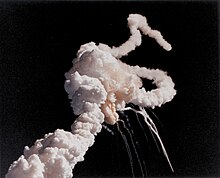
Rockets are not inherently highly dangerous. In military use, adequate reliability and safety is obtained. However, for space use, most flights have some risk.[87]
Because of the enormous chemical energy in useful rocket propellants (greater energy by weight than explosives, but lower than gasoline), accidents can, have and will happen. The number of people injured or killed is usually small because of the great care normally taken, but their record is not perfect.
Costs and economics
The costs of rockets can be roughly divided into propellant costs, the costs of obtaining and/or producing the 'dry mass' of the rocket and the costs of any required support equipment and facilities.[88]
Most of the takeoff mass of a rocket is normally propellant. However propellant is seldom more than a few times more expensive than gasoline per kg (as of 2009 gasoline is about $1/kg or less), and although substantial amounts are needed, for all but the very cheapest rockets it turns out that the propellant costs are usually comparatively small, although not completely negligible.[88]
The costs of the dry mass of the rocket depend largely on the manufacturing processes needed to shape and assemble it; the materials used are rarely expensive in and of themselves. For complete aerospace materials average costs of ~$10,000/kg (as of 2009) are common. This high cost is largely due to the manpower and equipment needed to form lightweight structures that perform well in rockets. Even though the dry mass of the rocket is usually a small fraction of the rocket (often between 1/10 and 1/40 of the rocket), nevertheless this cost dominates.
However the structure of simple rockets that are produced in large quantities can be many times cheaper,[88] while very high performance, complex structures that are produced in small quantities tend to be more expensive, although give more performance.
The costs of support equipment, range costs and launch pads generally scale up with the size of the rocket, but vary less with launch rate, and so may be considered to be approximately a fixed cost.[88]
See also
Lists
- Timeline of spaceflight
- Timeline of rocket and missile technology
- Chronology of Pakistan's rocket tests
- List of rockets
- Sounding rocket
- Spacecraft propulsion - describes many different propulsion systems for spacecraft
- Astrodynamics the study of spaceflight trajectories
General rocketry
- Ammonium Perchlorate Composite Propellant - Most common solid rocket fuel
- Bipropellant rocket - two-part liquid or gaseous fuelled rocket
- Tripropellant rocket - variable propellant mixes can improve performance
- Hot Water rocket - powered by boiling water
- Hybrid rocket - solid rocket burnt by second fluid propellant
- Pendulum rocket fallacy - an instability of rockets
- Pulsed Rocket Motors - solid rocket that burns in segments
- Rocket fuel
- Rocket launch
- Rocket launch site
- Rocket engine nozzles - De Laval nozzles
- Solid rocket
- Tsiolkovsky rocket equation - equation describing rocket performance
Recreational rocketry
- Model rocket - small hobby rocket
- High-powered rocket
- Water rocket - toy rocket launched for recreational purposes using water as propellant
- Balloon rocket
- Tripoli Rocketry Association
- National Association of Rocketry
Recreational pyrotechnic rocketry
- Bottle rocket - small firework type rocket often launched from bottles
- Skyrocket - fireworks that typically explode at apogee
Weaponry
- Rocket propelled grenade - military use of rockets
- Air-to-ground rockets
- Fire Arrow - one of the earliest types of rocket
- Shin Ki Chon Korean variation of the Chinese fire arrow
- Katyusha rocket launcher - rack mounted rocket
- VA-111 Shkval - Russian rocket propelled supercavitation torpedo
Rockets for Research
- Disappearing rocket - rocket that disintegrate if fired from the ground for safety reasons
- Rocket plane - winged aircraft powered by rockets
- Rocket sled - used for high speeds along ground
- Sounding rocket - suborbital rocket used for atmospheric and other research
Misc
- Rocket mail - an ill-fated attempt to commercialize rocketry
- Rocket Festival Tradition bamboo rockets of Laos and Northeastern Thailand
- Equivalence principle - Einstein was able to show that the effects of gravity were completely equivalent to a rocket's acceleration in any small region of space
Notes
- Footnotes
- ^ "With its ninth century AD origins in China, the knowledge of gunpowder emerged from the search by alchemists for the secrets of life, to filter through the channels of Middle Eastern culture, and take root in Europe with consequences that form the context of the studies in this volume."[2]
- ^ "Without doubt it was in the previous century, around +850, that the early alchemical experiments on the constituents of gunpowder, with its self-contained oxygen, reached their climax in the appearance of the mixture itself."[3]
- ^ (正大九年)其守城之具有火砲名「震天雷」者,铁罐盛药,以火点之,砲起火发,其声如雷,闻百里外,所爇围半亩之上,火点著甲铁皆透。(蒙古)大兵又为牛皮洞,直至城下,掘城为龛,间可容人,则城上不可奈何矣。人有献策者,以铁绳悬「震天雷」者,顺城而下,至掘处火发,人与牛皮皆碎迸无迹。又「飞火枪」,注药以火发之,辄前烧十余步,人亦不敢近。(蒙古)大兵惟畏此二物云。(Rough translation: Year 1232: Among the weaponry at the defense city Kaifeng are the "thundercrash", which are made of iron pot, filled with drugs black powder, that exploded after being lighted with fire, and made a noise like thunder. They could be heard from over 100 li, and could spread on more than a third of an acre, moreover they could penetrate the armours and the iron. The Mongol soldiers employed a siege carriage cloaked with cowskin, advanced to the city below, then grubbed a niche on the city-wall, which could spare a man between. The Jin defenders atop did not know what to do, but they got an advice later. Thus, they dropped the pot with an iron string from the fortress, and the pot reached to the niche area and exploded, blowing men and carriage to pieces without trace. The defenders also have the "flying fire-lance", which they infused with black powder and ignited it. This lance flamed within a range of over ten paces on the front, and no one dared to approach it. It was said that the Mongol soldiers could only be deterred by these two devices.) [6]
- ^ “thrust-to-weight ratio F/Wg is a dimensionless parameter that is identical to the acceleration of the rocket propulsion system (expressed in multiples of g0) ... in a gravity-free vacuum”[84]
- Citations
- ^ MSFC History Office "Rockets in Ancient Times (100 B.C. to 17th Century)"
- ^ Buchanan 2006, p. 2
- ^ Needham 1986, p. 7
- ^ Chase 2003, pp. 31–32
- ^ a b c "A brief history of rocketry". NASA Spacelink. Retrieved 2006-08-19.
- ^ History of Jin ch. 113
- ^ Crosby 2002, pp. 100–103
- ^ Needham 1986, p. 510
- ^ Hassan & a
- ^ Hassan & b
- ^ von Braun & Ordway 1966[page needed]
- ^ CONRAD HAAS Raketenpionier in Siebenbürgen (german)
- ^ Nowak 1969, p. 182
- ^ History of the Rocket - 1804 to 1815 by Gareth Glover
- ^ Cite error: The named reference
congrevewas invoked but never defined (see the help page). - ^ Space History Division 1999
- ^ Tsiolkovsky's Исследование мировых пространств реактивными приборами - The Exploration of Cosmic Space by Means of Reaction Devices (Russian paper)
- ^ Johnson 1995, pp. 499–521
- ^ Esnault-Pelterie 1913
- ^ US patent 1,102,653
- ^ Goddard 1919
- ^ "Topics of the Times". New York Times. January 13, 1920. Archived from the original on 2008-02-09. Retrieved 2007-06-21.
{{cite news}}: Cite has empty unknown parameter:|coauthors=(help) - ^ Jürgen Heinz Ianzer, Hermann Oberth, pǎrintele zborului cosmic ("Hermann Oberth, Father of Cosmic Flight") (in Romanian), pp. 3, 11, 13, 15.
- ^ Konstantin Tsiolkovsky - Rockets from Russia
- ^ Goddard 2002, pp. 2, 15
- ^ Clary 2003, pp. 44–45
- ^ The Internet Encyclopedia of Science, history of rocketry: Opel-RAK
- ^ History of Rocketry: Verein für Raumschiffahrt (VfR)
- ^ A Rocket Drive For Long Range Bombers by E. Saenger and J. Bredt, August 1944
- ^ van der Linden, Frank H (November 2007), "Out of the Past", Aerospace America, pp. p39
{{citation}}:|first2=missing|last2=(help);|pages=has extra text (help); More than one of|last1=and|last=specified (help) - ^ The V-2 ballistic missile
- ^ Hunt 1991, pp. 72–74
- ^ Béon 1997[page needed]
- ^ "Messerschmitt Me 163 Komet." World War 2 Planes. Retrieved: 22 March 2009.
- ^ Joint Intelligence Objectives Agency. US National Archives and Records Administration
- ^ von Braun 1963, pp. 452–465
- ^ International Space Hall of Fame: Sergei Korolev
- ^ "Rocket R-7". S.P.Korolev RSC Energia.
- ^ Hansen 1987 Chapter 12.
- ^ Allen & Eggers 1958
- ^ (PDF) Hypersonics Before the Shuttle: A Concise History of the X-15 Research Airplane (NASA SP-2000-4518, 2000)
- ^ Houchin 2006[page needed]
- ^ New York Times 17 June 1969 - A Correction
- ^ GAO 1972[page needed]
- ^ GLOBAL POSITIONING SYSTEMS WING
- ^ NASA's great observatories
- ^ Futron report
- ^ NASA History: Rocket vehicles
- ^ OPEL Rocket vehicles
- ^ Polmar 2004, p. 304
- ^ Baker 2000, p. 581
- ^ The Rocketman
- ^ United States Congress. House Select Committee on Astronautics and Space Exploration (1959). "4. Rocket Vehicles". Space handbook: Astronautics and its applications : Staff report of the Select Committee on Astronautics and Space Exploration. House document / 86th Congress, 1st session, no. 86. Washington (DC): U.S. G.P.O. OCLC 52368435.
{{cite book}}: External link in|chapterurl=|chapterurl=ignored (|chapter-url=suggested) (help); Unknown parameter|coauthor=ignored (|author=suggested) (help) - ^ a b c d e f g h i j k l Sutton 2001 chapter 1
- ^ Concise Britannica- internal combustion engines
- ^ Marconi 2004
- ^ "Test sets world land speed record". www.af.mil. Retrieved 2008-03-18.
- ^ Stillwell, Wendell H (1964). "Chapter 2: The First Hypersonic Airplane". X-15 Research Results. NASA.
{{cite book}}: External link in|chapterurl=|chapterurl=ignored (|chapter-url=suggested) (help) - ^ Spaceflight Now-worldwide launch schedule
- ^ ApolloSaturn:Apollo launch escape subsystem
- ^ a b Astronautix.com:Soyuz T-10-1 "Launch vehicle blew up on pad at Tyuratam; crew saved by abort system"
- ^ Howstuff works ejection seats
- ^ THE ROCKET BELT
- ^ Sammy Miller
- ^ Potter & Crocker 1966[page needed]
- ^ Potter & Crocker 1966[page needed]
- ^ Potter & Crocker 1966[page needed]
- ^ NASA- Four forces on a model rocket
- ^ a b Aerospaceweb:Space Shuttle Max-Q
- ^ Glasstone 1965 p. 209.
- ^ Callaway 2004, p. 2
- ^ Huzel & Huang 1971[page needed]
- ^ General electric J-85
- ^ ThrustSSC Mach 1 Club: ART ARFONS LAST STAND by Richard Noble J-85 has "5.6 lbs of thrust for each pound of engine"
- ^ Sutton 2001 eq-2-14
- ^ Sutton 2001, p. 27
- ^ Sutton 2001, p. 29
- ^ "table of cislunar/mars delta-vs". Archived from the original on 2007-07-01.
- ^ cislunar delta-vs
- ^ Choose Your Engine
- ^ The Evolution of Rockets
- ^ Rocket Mass Ratios
- ^ NASA 2006
- ^ a b Sutton 2001, p. 442
- ^ Astronautix NK-33 entry
- ^ a b c d Sutton 2001, pp. 37–38
- ^ A brief history of space accidents, Janes, 03 February 2003
{{citation}}: Check date values in:|date=(help) - ^ a b c d A Rocket a Day Keeps the High Costs Away by John Walker September 27, 1993
References
- Allen, H. Julian; Eggers, A. J. (1958). A Study of the Motion and Aerodynamic Heating of Ballistic Missiles Entering the Earth's Atmosphere at High Supersonic Speeds (PDF). NACA. OCLC 86134556.
- Baker, A. D. (2000). Combat Fleets of the World 2000-2001. Annapolis: US Naval Institute Press. ISBN 9781557501974.
- Béon, Yves (1997). Planet Dora: A Memoir of the Holocaust and the Birth of the Space Age. translated from the French La planète Dora by Béon & Richard L. Fague. Westview Press, Div. of Harper Collins. ISBN 0-8133-3272-9.
- Buchanan, Brenda (2006). Gunpowder, Explosives and the State. Aldershot: Ashgate. ISBN 9780754652595.
- Callaway, David W. (2004). "Coplanar Air Launch with Gravity-Turn Launch Trajectories" (PDF). Masters Thesis.
{{cite journal}}: Unknown parameter|month=ignored (help) - Chase, Kenneth (2003). Firearms : A global history to 1700. Cambridge: Cambridge University Press. ISBN 9780521822749.
- Clary, David (2003). Rocket Man. New York: Theia. ISBN 9780786868179.
- Crosby, Alfred W. (2002). Throwing Fire: Projectile Technology Through History. Cambridge: Cambridge University Press. ISBN 0521791588.
- Esnault-Pelterie, Robert (1913). "Considerations sur les resultats d'un allegement indefini des moteurs". Journal de physique theorique et appliquee (in French). Paris. OCLC 43942743.
- GAO (1972), Cost Benefit Analysis Used in Support of the Space Shuttle Program (PDF), Washington, DC: General Accounting Office, US Government
- Glasstone, Samuel (1965). Sourcebook on the Space Sciences. D. Van Nostrand Company. OCLC 232378.
- Goddard, Robert (1919). A Method of Reaching Extreme Altitudes (PDF). OCLC 3430998.
- Goddard, Robert (2002). Rockets. New York: Dover Publications. ISBN 9780486425375.
- Hansen, James R. (1987). "Engineer in Charge: A History of the Langley Aeronautical Laboratory, 1917-1958". The NASA History Series, sp-4305. NASA. OCLC 246830126.
- Harford, James (1997). Korolev: How One Man Masterminded the Soviet Drive to Beat America to the Moon. John Wiley & Sons. ISBN 0-471-14853-9.
{{cite book}}: Cite has empty unknown parameter:|coauthors=(help) - Hassan, Ahmad Y (a). "Gunpowder Composition for Rockets and Cannon in Arabic Military Treatises In Thirteenth and Fourteenth Centuries". History of Science and Technology in Islam. Retrieved 2008-03-29.
{{cite web}}: Check date values in:|year=(help)CS1 maint: year (link) - Hassan, Ahmad Y (b). "Transfer Of Islamic Technology To The West, Part III: Technology Transfer in the Chemical Industries". History of Science and Technology in Islam. Retrieved 2008-03-29.
{{cite web}}: Check date values in:|year=(help)CS1 maint: year (link) - Houchin, Roy (2006). U.S. Hypersonic Research and Development: The Rise and Fall of Dyna-Soar, 1944–1963. New York: Routledge. ISBN 0-415-36281-4.
- Hunt, Linda (1991). Secret Agenda: The United States Government, Nazi Scientists, and Project Paperclip, 1945 to 1990. New York: St.Martin's Press. ISBN 0-3120-5510-2.
- Huzel, D. K.; Huang, D. H. (1971). NASA SP-125, Design of Liquid Propellant Rocket Engines (2nd ed.). NASA.
- Johnson (June 1995). "Contents and commentary on William Moore's a treatise on the motion of rockets and an essay on naval gunnery". International Journal of Impact Engineering. 16 (3). OCLC 105570427.
- Marconi, Elaine M. (April 12, 2004). "What is a Sounding Rocket?". Research Aircraft. NASA. Retrieved October 10, 2006.
- NASA (2006). "Rocket staging". Beginner's Guide to Rockets. NASA. Retrieved 2009-06-28.
- Needham, Joseph (1986). Science and Civilisation in China. Cambridge: Cambridge University Press. ISBN 9780521303583.
- Nowak, Tadeusz (1969). Kazimierz Siemienowicz ok.1600-ok.1951 (in Polish). Warsaw: MON Press. OCLC 254130686.
- Polmar, Norman (2004). Cold War Submarines. Washington: Brassey's. ISBN 9781574885941.
- Potter, R.C; Crocker (1966). Acoustic Prediction Methods for Rocket Engines, Including the Effects of Clustered Engines and Deflected Exhaust Flow, CR-566 (PDF). Washington, D.C.: NASA. OCLC 37049198.
{{cite book}}: Unknown parameter|first 2=ignored (|first2=suggested) (help) - Space History Division (1999). "Hale 24-Pounder Rocket". Smithsonian National Air and Space Museum. Archived from the original on 2007-08-18.
- Stephen, Leslie (1887). Dictionary of National Biography. Vol. XII. New York: Macmillan.
- Sutton, George (2001). Rocket Propulsion Elements (7th ed.). Chichester: John Wiley & Sons. ISBN 9780471326427.
- Van Riper, A Bowdoin (2004). Rockets and Missiles. Westport: Greenwood Press. ISBN 9780313327957.
- von Braun, Wernher; Ordway, Frederick Ira (1966). History of rocketry & space travel. New York: Crowell. OCLC 566653.
- von Braun, Wernher (1963). Emme, Eugene Morlock (ed.). "The History of Rocket Technology: The Redstone, Jupiter and Juno". Technology and Culture. IV (4): 452–465. OCLC 39186548.
{{cite journal}}: Unknown parameter|month=ignored (help)
- MSFC History Office. "Rockets in Ancient Times (100 B.C. to 17th Century)". A Timeline of Rocket History. NASA. Retrieved 2009-06-28.
External links
- Governing agencies
- about the rocket in israel
- FAA Office of Commercial Space Transportation
- National Aeronautics and Space Administration (NASA)
- National Association of Rocketry (USA)
- Tripoli Rocketry Association
- Asoc. Coheteria Experimental y Modelista de Argentina
- United Kingdom Rocketry Association
- Canadian Association of Rocketry
- Indian Space Research Organisation
- Information sites
























